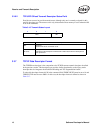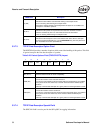
Receive and Transmit Description
50 Software Developer’s Manual
3.3.7.3 TCP/IP Data Descriptor Option Field
The POPTS field provides a number of options which control the handling of this packet. This field
is ignored except on the first data descriptor of a packet.
Table 3-20. Packet Options Field (TDESC.POPTS) Layout
3.3.7.4 TCP/IP Data Descriptor Special Field
The SPECIAL field is used to provide the 802.1q/802.3ac tagging information.
LC (bit2)
Late Collision
Indicates that late collision occurred while working in half-duplex mode.
It has no meaning while working in full-duplex mode.
Note that the collision window is speed dependent: 64 bytes for 10/100 Mb/s and
512 bytes for 1000 Mb/s operation.
EC (bit 1)
Excess Collision
Indicates that the packet has experienced more than the maximum excessive
collisions as defined by TCTL.CT control field and was not transmitted.
Is has no meaning while working in full-duplex mode.
DD (bit 0)
Descriptor Done
Indicates that the descriptor is done and is written back either after the descriptor
has been processed (with RS set), or for the 82554GC/EI only, after the packet has
been transmitted on the wire (with RPS set).
TDESC.STA Description
7 6 5 4 3 2 1 0
RSV RSV RSV RSV RSV RSV TXSM IXSM
TDESC.POPTS Description
RSV (bit 2-7)
Reserved
Should be written with 0b for future compatibility.
TXSM (bit1)
Insert TCP/UDP Checksum
Controls the insertion of the TCP/UDP checksum.
If not set, the value placed into the checksum field of the packet data is not modified,
and is placed on the wire. When set, TCP/UDP checksum field is modified by the
hardware.
Valid only in the first data descriptor for a given packet or TCP Segmentation context.
IXSM (bit 0)
Insert IP Checksum
Controls the insertion of the IP checksum.
If not set, the value placed into the checksum field of the packet data is not modified
and is placed on the wire. When set, the IP checksum field is modified by the
hardware.
Valid only in the first data descriptor for a given packet or TCP Segmentation context.


















